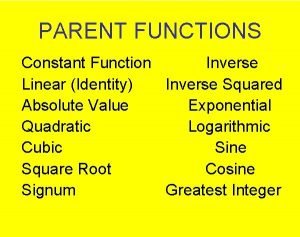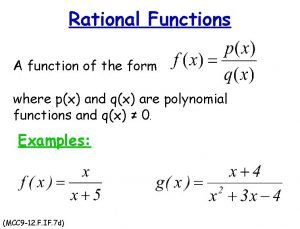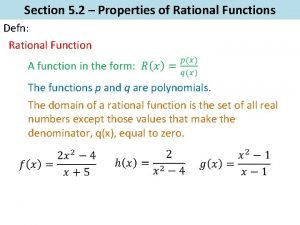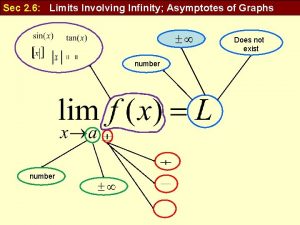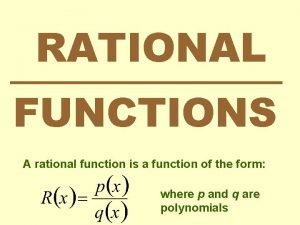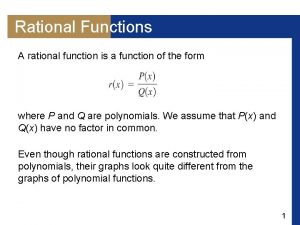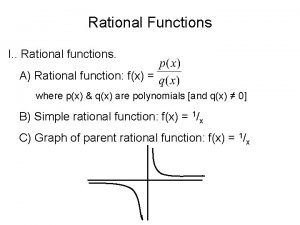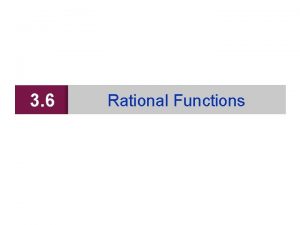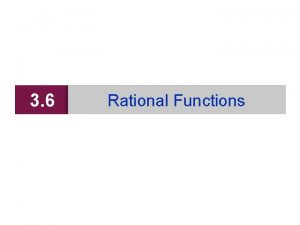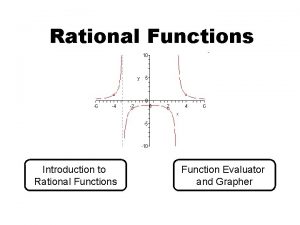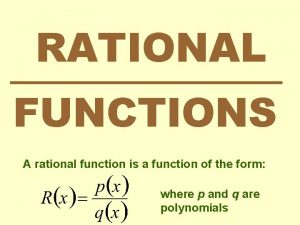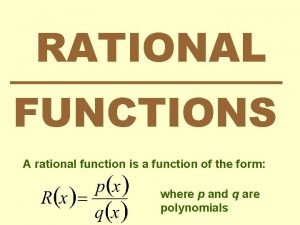Rational Functions A rational function is a function













- Slides: 13

Rational Functions

A rational function is a function of the form Where p and q are polynomial functions and q is not the zero polynomial. The domain consists of all real numbers except those for which the denominator is 0.

Find the domain of the following functions: All real numbers except -6 and-2. All real numbers except -4 and 4. All real numbers.

Behavior Near Undefined Values Examine the behavior of the function near the undefined values and as x goes to (as x goes to the extremes.


Vertical Asymptotes x=c y x=c x

Theorem Locating Vertical Asymptotes A rational function, in lowest terms, will have a vertical asymptote x = r, if x - r is a factor of the denominator q.

Find the vertical asymptotes, if any, of the graph of each rational function. Vertical asymptotes: x = -1 and x = 1 No vertical asymptotes Vertical asymptote: x = -4

Horizontal Asymptotes y y = R(x) y=L x y = R(x)

If an asymptote is neither horizontal nor vertical it is called oblique. y x

Consider the rational function 1. If n < m, then y = 0 is a horizontal asymptote of the graph of R. 2. If n = m, then y = an / bm is a horizontal asymptote of the graph of R. 3. If n = m + 1, then y = ax + b is an oblique asymptote of the graph of R. Found using long division. 4. If n > m + 1, the graph of R has neither a horizontal nor oblique asymptote. End behavior found using long division.

Find the horizontal and oblique asymptotes if any, of the graph of Horizontal asymptote: y = 0 Horizontal asymptote: y = 2/3

Oblique asymptote: y = x + 6
 Rational function parent function
Rational function parent function Parent function for rational functions
Parent function for rational functions Identity function parent function
Identity function parent function Rational fraction
Rational fraction 8-5 solving rational equations and inequalities
8-5 solving rational equations and inequalities Tux robot
Tux robot Asymptotes
Asymptotes Unit 8 rational functions homework 1
Unit 8 rational functions homework 1 Rational expressions and functions
Rational expressions and functions What are the properties of rational function?
What are the properties of rational function? Sec asymptotes
Sec asymptotes What is a rational function
What is a rational function Example of rational functions
Example of rational functions Radical functions and rational exponents practice
Radical functions and rational exponents practice


